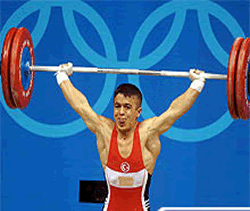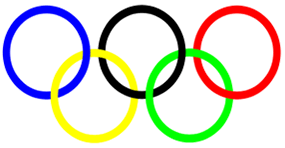Weight Lifting
Records

The total record in the men's 56 kg class is 305 kg; in the 105+ kg class it is 472.5 kg.[4] The current official record for the clean and jerk in the men's 105+ kg class is held by Hossein Rezazadeh of Iran, who clean and jerked 263.5 kg (580.9 lb) at the 2004 Athens Summer Olympics. He snatched 213.0 kg (469.6 lb) in September 2003 at Qinhuangdao. Rezazadeh scored a record total of 472.5 kg at both the 2000 Sydney Olympics and 2004 Athens Olympics. The current record for the clean and jerk in the women's 75+ kg class is held by Jang Mi-Ran of South Korea, who lifted 186 kg (410.07 lb) at the 2008 Beijing Summer Olympics.[4] Due to the restructuring of the competitive weight classes that took place in 1993 and 1998, the following lifts are no longer recognized as the official world records. However, these remain the highest figures ever posted in competition. Yevgeny Sypko lifted in the Druzhba Cup Meet, on March 4, 1990, at 130.65 kg and snatched 216.5kg (477.3 lb), the highest competitive snatch in history, although it is not recognized as a world record because the meet wasn't officially drug tested. However, it did count as a Soviet Record. The heaviest official snatch of all time is 216.0 kg (476.2 lb), lifted by Antonio Krastev of Bulgaria in 1987. That year Antonio's training produced a world record exceeding snatch of 222.5kg (490.5 lb). The heaviest clean and jerk of all time is 266.0 kg (586.4 lb) lifted by Leonid Taranenko in Canberra, Australia on November 26, 1988. In the same event, Taranenko set a world record of 475 kg (1047.2 lb) in the total.
Competition

The competitive sport is controlled by the International Weightlifting Federation (IWF). Based in Budapest, it was founded in 1905. Competitors compete in one of eight (seven for women) divisions determined by their body mass. These classes are currently: men's: 56 kg (123 lb), 62 kg (137 lb), 69 kg (152 lb), 77 kg (170 lb), 85 kg (187 lb), 94 kg (207 lb), 105 kg (231 lb), and over 105 kg; and women's: 48 kg (106 lb), 53 kg (117 lb), 58 kg (128 lb), 63 kg (139 lb), 69 kg (152 lb), 75 kg (165 lb), and over 75 kg.[2] In each weight division, competitors compete in both the snatch and clean and jerk, and prizes are usually given for the heaviest weights lifted in the snatch, clean and jerk, and the two combined. The order of the competition is up to the lifters—the competitor who chooses to attempt the lowest weight goes first. If they are unsuccessful at that weight, they have the option of reattempting that lift or trying a heavier weight later (after any other competitors have made attempts at that weight or any intermediate weights). Weights are set in 1 kilogram increments (previously 2.5 kg increments), and each lifter can have a maximum of three lifts, regardless of whether lifts are successful or not. The title "best lifter" is commonly awarded at local competitions. The award is based on the lifters' Sinclair Coefficients, which calculate strength-to-weight ratio of the lifters.[3] Typically, the winner of the heaviest weight class will have lifted the most weight, but a lifter in a lighter weight class will have lifted more in proportion to his bodyweight.
